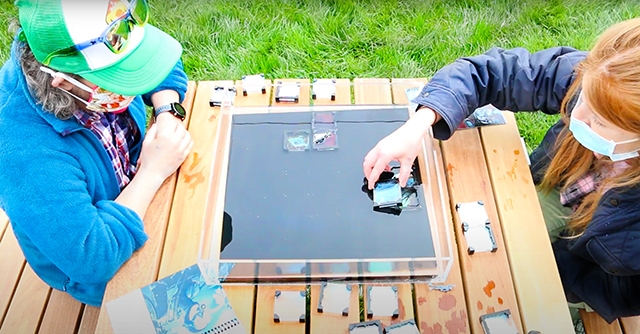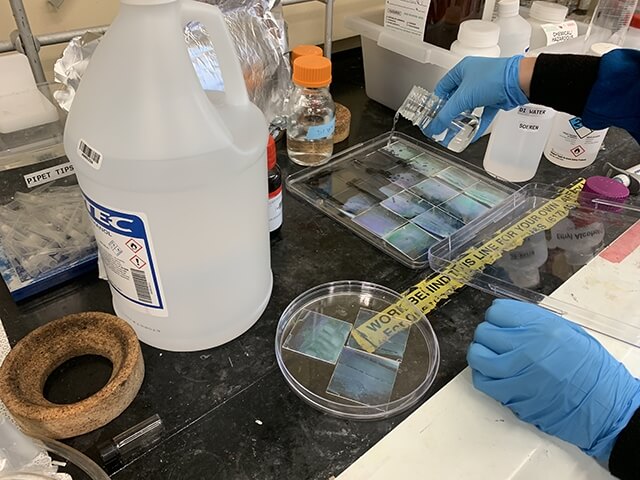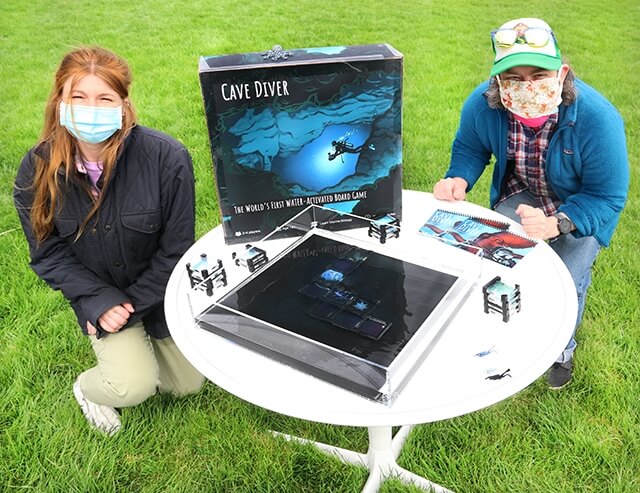News
Mike Deloge and Doria Spiegel demonstrate how Cave Diver is played. Photo by Jonathan Grinham
Nanotechnology could be on the table at your next board game night.
A team of Harvard students used nanostructured materials to create an educational board game that showcases the power of nanotechnology while teaching players about marine biology.
The game, Cave Diver, was born out of “Nano Micro Macro: Adaptive Material Laboratory” (ES 291), a hands-on John A. Paulson School of Engineering and Applied Sciences course that teaches about cutting-edge research in materials on the macroscale, microscale, and nanoscale, and then challenges players to use their knowledge to develop a group project. The course was taught by Joanna Aizenberg, Amy Smith Berylson Professor of Materials Science and Professor of Chemistry & Chemical Biology, and Jonathan Grinham, Lecturer in Architecture at the Graduate School of Design (GSD).
The Cave Diver team, comprised of Aaron Appleton, M.Ed. ’21, Danielle Davis, A.B. ’21, Mike Deloge, M.Des. ’22, and Doria Spiegel, M.D.E. ’22, focused their game around inverse opals, which are nanostructured porous materials that refract light to create structural color. The color of inverse opals is based on variations in their structure, so when liquid replaces air in the pores of an inverse opal, the color will change or disappear entirely.
“I found it interesting that it could be on a particular material and it would be hidden until it was exposed with a liquid, and then you could reveal some information or symbols,” said Appleton, who earned a master’s degree from the Graduate School of Education. “I thought that would work quite well for a game mechanic called hidden information, but you would need to use water with it. So that was the impetus for the cave diver theme.”
A team of Harvard students used nanostructured materials to create Cave Diver, an educational board game that showcases the power of nanotechnology while teaching players about marine biology. Video by Aaron Appleton.
The students devised a two-player game comprised of glass tiles that display pathways a diver follows in an underwater cave; paths can be straight, t-shaped, right angles, or cross-shaped. Players take turns adding tiles to the gameboard, which involves submerging them in water, and moving their characters along the underwater path as more tiles are added. But some tiles, when placed in liquid, reveal hidden paths or sea creatures that result in a penalty or bonus for the player.
This is where the inverse opals come in. The students designed some of the glass game tiles to be hydrophilic, so water can enter the pores of the inverse opals on the tiles and change their color, revealing a hidden path or a sea creature. For instance, if a tile reveals a blue marlin (one of the fastest fish in the ocean), the player is allowed to place one more tile during their turn to “speed ahead,” but if the tiles reveals a sea urchin and jellyfish (which can both give painful stings) the player must skip a turn to “nurse their wounds.”
Spiegel makes the glass pieces that will have animals on them hydrophobic, before the layer of polydimethylsiloxane (PDMS) is added over top of them.
The game has 45 glass tiles, and 20 of them reveal hidden images. Painstakingly designing so many tiles and ensuring the 20 were functionalized properly was a major challenge, said Spiegel. With the help of project mentor Natalie Nicolas, senior staff scientist James Weaver, and teaching fellows Peter Lazovskis and Milan Wilborn, Spiegel spent several days working in the labs cutting glass, 3D printing cases for the tiles, and putting them together with magnets to hold them to the board.
“It took a lot of iteration, realizing what would work and what wouldn’t work,” said Spiegel, who is pursuing a master’s in design engineering, jointly offered by SEAS and the GSD. “Coming into it, we knew if we planned ahead enough we would be able to have a fully functional product, and we did. That took a lot of forethought in order to do it correctly the first or second time.”
Carefully depositing the inverse opals onto the tiles was another major challenge, as was developing the intricate sea creature shapes that would be revealed.
As the game was nearing completion, the team realized the tiles were more difficult to functionalize in water than they expected. But the tiles performed well in alcohol, so when they demonstrated Cave Diver to their classmates and instructors, the team used a game board submerged in vodka.
Spiegel and Deloge with the completed Cave Diver game. Photo by Jonathan Grinham
After successfully presenting their game to the class, Deloge and Spiegel celebrated by meeting outside the Science and Engineering Complex to play Cave Diver in person.
“After a virtual semester, to see something in person and real and tangible that we created was so rewarding,” said Deloge, who is pursuing a master’s in design studies at the GSD.
While they faced many challenges over the course of the semester, the teammates had fun working on complex problems and collaborating to create something they could all be proud of.
“I am really happy to see an incredibly diverse group of undergraduate and graduate students coming from engineering, design and education programs learn a great deal about how to apply nanotechnology to a practical product and how different disciplines can come together to create something that is greater than the sum of its parts,” said Aizenberg.
“The coolest projects are the ones that are interdisciplinary in nature, because you are getting the best of both worlds,” said Davis, an engineering sciences concentrator. “This project is not just a game, it is not just for fun, and it is not just purely educational, but it is based on science and has all these multi-facets that makes it interesting and engaging for people of any age.”
Topics: Academics
Cutting-edge science delivered direct to your inbox.
Join the Harvard SEAS mailing list.
Press Contact
Adam Zewe | 617-496-5878 | azewe@seas.harvard.edu





